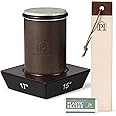A razor-sharp knife isn’t just about aesthetics; it’s about safety and efficiency in the kitchen. Understanding the science behind knife sharpening angles is crucial to achieving that perfect edge. While it might seem like a simple process, the angle at which you sharpen your blade significantly impacts its performance, longevity, and your overall cutting experience. This article delves into the physics and practical applications of knife sharpening angles, helping you transform from a novice to a confident blade-honing expert.
The Importance of the Sharpening Angle

The sharpening angle, simply put, is the angle formed between the blade’s bevel and the sharpening surface (whether it’s a whetstone, honing steel, or electric sharpener). This angle dictates the sharpness and durability of the blade. A sharper blade, created with a smaller angle, will slice more easily, while a more obtuse angle creates a more robust, durable edge that can withstand more pressure.
The ideal angle varies considerably depending on the knife type and intended use. For example, a chef’s knife might benefit from a 20-degree angle, offering an excellent balance between sharpness and durability. A paring knife, used for more delicate work, could be sharpened to a slightly sharper 15-degree angle. However, a hunting knife, designed for tougher tasks, might employ a more robust 25-degree or even 30-degree angle.
Understanding the Physics of a Sharp Edge
At its core, knife sharpening is about creating a precisely angled micro-bevel on the blade’s edge. This micro-bevel is not a single point, but rather a very thin, extremely sharp edge formed by the intersection of two meticulously ground surfaces. The smaller the angle, the sharper the edge, as it effectively concentrates the force over a smaller area, creating less resistance when slicing. The material’s hardness (measured on the Rockwell scale) and your sharpening technique will play a significant role in the process.
The Role of Torque in Sharpening

While not directly related to the angle itself, torque plays a significant role in achieving a consistent and effective sharpening angle. Consistent application of pressure and a smooth, controlled motion are crucial. Too much pressure can lead to uneven sharpening or even damage the blade, while too little pressure will result in a slow and ineffective sharpening process. Think of it like this: torque ensures you apply the appropriate force consistently along the blade’s length, creating a uniform bevel on both sides.
This is where the choice of sharpening tool comes into play. Hand-held whetstones, for example, require a degree of finesse and control to maintain the appropriate torque throughout the sharpening process. Electric sharpeners often take this aspect out of the equation with their automated mechanisms, but careful attention to their instructions is still essential to avoiding issues.
Sharpening Tools and Their Impact on Angle Consistency
The tools you choose play a significant role in maintaining a consistent sharpening angle. Each tool provides a slightly different approach and demands a different level of skill:
- Whetstones: Offer the greatest control and allow for fine-tuning of the angle. However, they require practice and patience to master.
- Honing Steel: Doesn’t actually sharpen the blade but realigns the edge, extending the life of a sharp blade. It doesn’t change the angle.
- Electric Sharpeners: Offer convenience and speed, but may not always produce the perfect angle for every blade. Some electric sharpeners offer angle adjustment options.
- Pull-through Sharpeners: Relatively easy to use, but often lack precision and can damage the blade if not used correctly. These should only be used in rare occasions.
Maintaining Consistent Angles: Tips and Techniques

Maintaining a consistent sharpening angle across the entire blade is critical for an optimally sharp knife. Here are some tips:
- Use a sharpening guide or jig: These tools help maintain the desired angle while sharpening, especially useful for beginners.
- Use consistent pressure: Avoid pressing too hard or too lightly on the blade while sharpening.
- Use a slow and steady motion: Rushing the process can lead to inconsistencies and damage.
- Sharpen both sides equally: Ensure you spend an equal amount of time sharpening each side of the blade to maintain symmetry.
- Use a lubricant: Water or honing oil reduces friction and helps prevent overheating and damage to the blade.
Choosing the Right Angle for Your Knives

The ideal sharpening angle isn’t a one-size-fits-all solution. It’s a balance between sharpness and durability. Generally:
- High-carbon steel knives often benefit from sharper angles (15-20 degrees).
- Stainless steel knives, being tougher, might handle slightly larger angles (20-25 degrees).
- Very hard ceramic knives, require a specialized approach and are typically sharpened at slightly obtuse angles (25-30 degrees) using diamond sharpeners.
Experimentation is key. Start with a commonly recommended angle for your knife type and adjust as needed. The feel of the blade’s sharpness against your thumb will help guide your sharpening angle refinements.
Conclusion: Mastering the Art of Sharpening Angles
Mastering knife sharpening angles is a journey, not a destination. By understanding the physics behind the process, using the right tools, and employing the techniques described above, you can achieve razor-sharp knives that elevate your culinary skills and enhance your kitchen safety. Remember that practice makes perfect, so don’t be discouraged if your first attempts aren’t flawless. With patience and persistence, you’ll become a confident knife-sharpening expert.








